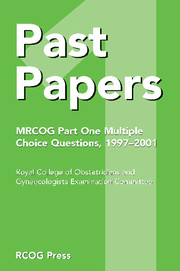Book contents
- Frontmatter
- Contents
- Introduction
- March 1997 – Paper 1
- March 1997 – Paper 2
- September 1997 – Paper 1
- September 1997 – Paper 2
- March 1998 – Paper 1
- March 1998 – Paper 2
- September 1998 – Paper 1
- September 1998 – Paper 2
- March 1999 – Paper 1
- March 1999 – Paper 2
- September 1999 – Paper 1
- September 1999 – Paper 2
- March 2000 – Paper 1
- March 2000 – Paper 2
- September 2000 – Paper 1
- September 2000 – Paper 2
- March 2001 – Paper 1
- March 2001 – Paper 2
- September 2001 – Paper 1
- September 2001 – Paper 2
- Index
March 2001 – Paper 1
Published online by Cambridge University Press: 05 July 2014
- Frontmatter
- Contents
- Introduction
- March 1997 – Paper 1
- March 1997 – Paper 2
- September 1997 – Paper 1
- September 1997 – Paper 2
- March 1998 – Paper 1
- March 1998 – Paper 2
- September 1998 – Paper 1
- September 1998 – Paper 2
- March 1999 – Paper 1
- March 1999 – Paper 2
- September 1999 – Paper 1
- September 1999 – Paper 2
- March 2000 – Paper 1
- March 2000 – Paper 2
- September 2000 – Paper 1
- September 2000 – Paper 2
- March 2001 – Paper 1
- March 2001 – Paper 2
- September 2001 – Paper 1
- September 2001 – Paper 2
- Index
Summary
1. The anal canal
A. has an upper part which is innervated by the inferior hypogastric plexus.
B. has a lower part which is supplied by the superior rectal artery.
C. drains lymph to the superficial inguinal nodes from its upper part.
D. has its internal sphincter innervated by the inferior rectal nerve.
E. has a superficial part of its external sphincter attached to the coccyx.
2. The pelvic splanchnic nerves
A. are derived from the posterior rami of the sacral spinal nerves.
B. supply afferent fibres.
C. mix with branches of the sympathetic pelvic plexus.
D. supply the ascending colon with motor fibres.
E. supply the uterus with parasympathetic fibres.
3. Concerning histological constituents:
A. The round ligament contains smooth muscle fibres.
B. The bladder epithelium has no mucous glands.
C. The whole of the urethra is lined by squamous epithelium.
D. The sacroiliac joint has a synovial membrane.
E. Skene's glands are present in the clitoris.
4. The following statements about the diaphragm are correct:
A. The greater splanchnic nerves pierce the central tendon.
B. The aortic aperture transmits the thoracic duct.
C. The vena caval aperture transmits the left phrenic nerve.
D. The oesophageal aperture transmits the vagus nerves.
E. Motor fibre supply is by the intercostal nerves.
- Type
- Chapter
- Information
- Past Papers MRCOG Part One Multiple Choice Questions1997–2001, pp. 162 - 171Publisher: Cambridge University PressPrint publication year: 2004



